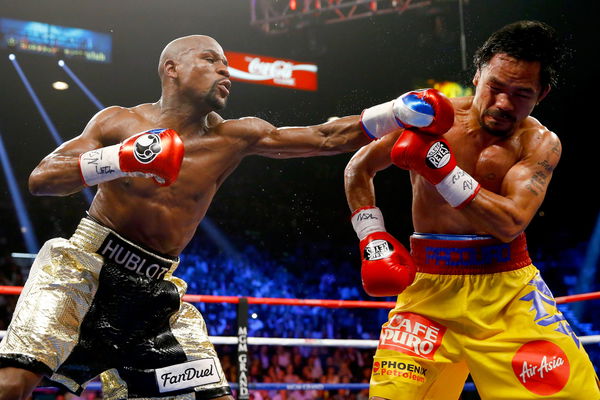
via Getty
LAS VEGAS, NV – MAY 02: Floyd Mayweather Jr. throws a left at Manny Pacquiao during their welterweight unification championship bout on May 2, 2015 at MGM Grand Garden Arena in Las Vegas, Nevada. (Photo by Al Bello/Getty Images)

via Getty
LAS VEGAS, NV – MAY 02: Floyd Mayweather Jr. throws a left at Manny Pacquiao during their welterweight unification championship bout on May 2, 2015 at MGM Grand Garden Arena in Las Vegas, Nevada. (Photo by Al Bello/Getty Images)
Boxing is a retro sport going strong until today. Boxers put in their all to procure that much needed ‘W’ on their resumes. Over the years, this extensive sport has seen some major revamp in its rules, regulations, and norms. Such changes play a vital role in the decision-making of fights in boxing.
Boxing results can be a little tricky and difficult to understand at times. But here, we break down all sorts of decisions of this sport and try to understand them.
ADVERTISEMENT
Article continues below this ad
Types of decisions in boxing:
Point Decision (PTS)
In this metric, a single judge or referee scores the contest after each round, just like the usual three-judge panel does. Predominantly it used in amateur boxing matches where fighters are new to the sport with less than 10 fights. The UK is one chief user of this metric for non-title bouts.
Unanimous Decision (UD)
It is one of the renowned methods to determine fight results that go a long distance. Here all three judges score the contest in favor of a single boxer. For example, between fighter ABC vs XYZ, all three judges have scored unanimously for fighter ABC.

The highly enigmatic clash between Floyd Mayweather and Marcos Maidana 2 ended with the American winning it by UD.
Read – Floyd Mayweather Sends a Heartfelt Message for Dr. Dre’s Recovery
Split Decision (SD)
In a split decision, 2 judges score the contest in favor of one boxer, whereas the third judge scores in favor of the latter boxer. In a bout between ABC vs XYZ, two judges score ABC as the winner, whereas one judge scores for XYZ as the winner.

For example, Canelo Alvarez won his bout against Erislandy Lara with an SD on the judges’ scorecard.
Majority Decision (MD)
Here, two judges score the contest in favor of one boxer, whereas the third judge scores for a draw. In between ABC vs XYZ, two judges score the contest for ABC and the other judge keeps it as even or a draw for the contest.

For example, Canelo Alvarez’s MD win over Gennady Golovkin in their rematch.
Read – Anthony Joshua Confident Oleksandr Usyk Will Let the Tyson Fury Fight Happen First
Knock-Out (KO)
This is indeed the most loved metric for a fight result. Fans, judges, and match officials like to see fights ending quickly. Here, a boxer is knocked down, and is unable to regain a vertical base before the referee finishes the count of 10.
Ryan Garcia bagged a similar win against Luke Campbell in round 7 of their title fight.

via Getty
DALLAS, TEXAS – JANUARY 02: Ryan Garcia (L) lands a left hook agains Luke Campbell during the WBC Interim Lightweight Title fight at American Airlines Center on January 02, 2021 in Dallas, Texas. (Photo by Tim Warner/Getty Images)
Technical Knock-Out (TKO)
In a technical knock-out, the referee analyses a fighter’s condition after a knockdown and ends the contest right there as the boxer is unfit to continue.
Anthony Joshua won one of the biggest fights of his life against Wladimir Klitschko with an astonishing TKO.

via Getty
LONDON, ENGLAND – APRIL 29: Anthony Joshua (White Shorts) catches Wladimir Klitschko (Grey Shorts) with a right hand upper cut in the 11th round of their IBF, WBA and IBO Heavyweight World Title bout at Wembley Stadium on April 29, 2017 in London, England. (Photo by Richard Heathcote/Getty Images)
Disqualification (DQ)
This occurs when a boxer commits a severe foul or continues to do so. The fight is called off by the referee and match officials if they suspect an intentional headbutt, elbow hits, low blows, and more.

For example, Mike Tyson was disqualified for biting Evander Holyfield’s ear again and again, even after several warnings.
Also Read – Deontay Wilder vs Francis Ngannou: Comparing the Hardest Punchers From Boxing and UFC
ADVERTISEMENT
Article continues below this ad
Retirement (RTD)
Here, a boxer or his corner communicates to the referee that their boxer will not be able to continue This can only happen in between two rounds and not during the rounds.
For example, Joshua Franco’s RTD win over Elton Dharry.
ADVERTISEMENT
Article continues below this ad
Read – Eddie Hearn Keen on Booking Callum Smith vs Joshua Buatsi for the Light-Heavyweight Title
Of all the above, which one is your favorite decision in boxing and why?
ADVERTISEMENT
ADVERTISEMENT
ADVERTISEMENT
